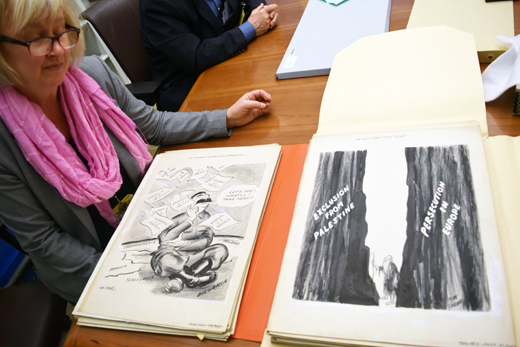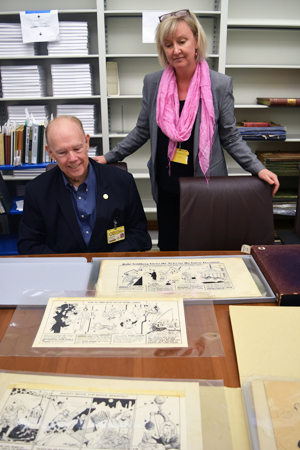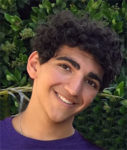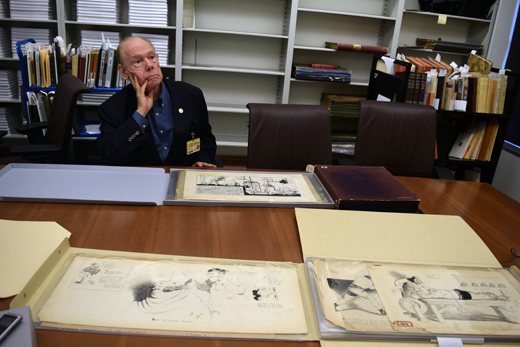
Story by Donald H. Harrison; Photos by Shor M. Masori



BERKELEY, California – This coming May will once again be Jewish American Heritage Month. The theme for this annual celebration will be “American Jewish illustrators” —and perhaps none is better known than Rube Goldberg, who donated a collection of more than 5,000 of his cartoons back in 1964 to the Bancroft Library on the UC Berkeley campus.
Over his career, Goldberg was a sports cartoonist, a political cartoonist (for which he won a Pulitzer Prize), but he is most remembered – even revered – as the cartoonist who invented very complicated machines to do the most simple tasks. His facetious machines, which he cartooned for a syndicated column, became so famous that his name was entered into Webster’s Dictionary while he was still alive.
Rube Goldberg – 1, Having a fantastically complicated improvised appearance: A Rube Goldberg arrangement of flasks and test tubes. 2. Deviously complex and impractical: A Rube Goldberg scheme for reducing taxes.
The National Cartoonist Society, of which he was a founding member, named its annual award for excellence in cartooning “The Reuben” in his honor, but notwithstanding the many encomiums directed his way, Goldberg kept a sense of humor about himself. As reported by University Archivist William Roberts in the Fall 1998 edition of Bancroftiana, the newsletter of the Bancroft Library, Goldberg wrote on Nov. 1, 1963 to Chancellor Edward W. Strong: “I have literally thousands of original cartoons on hand and am wondering just how many I should send. I do not want to clutter up the Library.”
The library was happy to get as many as Goldberg was willing to offer, a collection that now is kept in 55 portfolios in the Bancroft’s special collections department. Goldberg had studied mining engineering at UC Berkeley, graduating in 1904 and promptly taking a job designing sewers for the City of San Francisco, a job for which Goldberg admitted that he “displayed a woeful lack of enthusiasm,” according to a 2013 Bancroftiana article about the Goldberg collection.
The Bancroft’s Deputy Director, Peter Hanff, recalled in an interview that when he first came to work at the Bancroft Library he was told to familiarize himself with at least three special collections. He chose one about the War Relocation Board, the federal agency that was responsible for yanking Japanese-Americans from their homes and interning them unjustly in special camps during World War II; another about Abner Doble, the local inventor of a steam engine automobile, which could accelerate up hills too challenging for the internal combustion engine; and the third, the Rube Goldberg collection, some of which may be viewed by request in the Special Collections Reading Room.

Hanff said that Goldberg was active during his undergraduate years on the Pelican, which was the campus humor magazine. “He had been drawing and tracing since he was a little kid, as far as I know, and so it was a skill set that he had for a very early age,” Hanff informed. “He got work in San Francisco newspapers as a cartoonist initially, and then he was good enough that he was somehow able to move over to New York City.”
To be found among the library holdings is a typical cartoon of a Goldberg machine entitled “Special Treatment for a Woman Who Keeps Her Hat on in the Movies. Its explanatory caption reads: Glamorous matador Pat McCormick (A) sidesteps bull (B) who crashes into the Leaning Tower of Pisa (C). Joe Wallcott (D) who reads that tower will fall in 2153 is scared into doing roadwork for the title fight. He runs on a treadmill (E) powdering [Estes] Kefauver’s nose (F) for TV campaign appearances. Margaret Truman (G) coughs from the powder and reaches for gargle, causing a bullet to drop a giraffe in seat in front of a woman wearing a hat. Woman getting a dose of her own medicine leaves theatre in a huff. Giraffe leaves soon after because giraffes, as a rule, are not fond of movies.”
The references were to popular celebrities of the day. Patricia McCormick was an American-born bullfighter. Jersey Joe Wallcott won the heavyweight boxing championship on July 18, 1951 from Ezzard Charles, and lost it on Sept. 23, 1952 to Rocky Marciano. Senator Estes Kefauver of Tennessee was the vice presidential running mate for Democratic presidential nominee Adlai Stevenson in 1952. Margaret Truman was the daughter of President Harry S. Truman. It was considered quite an honor to be incorporated in such fashion in one of Goldberg’s cartoons.
While Goldberg had his public laughing about his inventions, his political cartoons—particularly those critical of Nazi Germany—stirred up some deep hatred against him, so much so that Goldberg had his two sons, George and Thomas, change their last names. Thomas decided to honor his older brother by changing his last name to George. The older brother followed suit, becoming George W. George.
In announcing that American Jewish illustrators would be the theme this year of American Jewish History Month, Ivy Barsky, CEO of the national Museum of American Jewish History, lead sponsor of the month, stated, “JAHM’s 2019 theme provides an opportunity to highlight the many American Jews who have helped create the nation’s beloved children’s books, iconic graphic novels and their superheroes, and syndicated comics and illustrations. These Jewish artists, illustrators, and writers have been shaped by American life, society and culture, and in turn enriched America’s imaginative landscape. Through the prism of their Jewish identity, and often by approaching their work through the lens of social justice, they have been able to make poignant observations about the world around them, offering powerful commentary on issues of the day through their unique and universal medium.”
About Rube Goldberg, Barsky commented that he “is one of the most influential and prolific cartoon illustrators of the twentieth century who is best known for his whimsical invention drawing cartoons, and also won a Pulitzer Prize for his political cartoon about the Atom Bomb.” The cartoon showed a large bomb teetering over a cliff titled “world control” toward a valley titled “world destruction.” On top of the bomb was a small suburban home, with a family innocently enjoying a day on their lawn.
Others given special mention in this year’s edition of the celebration that was established back in 2006 by proclamation of President George W. Bush were children’s book authors and illustrators Ezra Jack Keats, Bernard Waber and Maira Kalman; Marvel Comics executive Stan Lee; Superman co-creators Jerry Siegel and Joe Shuster; New Yorker cartoonist Roz Chast; graphic novelist Leela Corman; and undergound comics artist Diana Noomin.
Christine Hult-Lewis, Ph.D, who is the Reva and David Logan Curatorial Assistant in the Bancroft Library’s Pictorial Collection said many, but not all, of Goldberg’s drawings will be accessible to Bancroft Library visitors, whether or not the visitors are affiliated with UC Berkeley. “We are a public library,” she said. All that is needed to view collections is a passport or some other form of government-issued identification. Because some drawings are in the process of being minutely described for “finding aids,” some parts of the collection will be unavailable.
*
Harrison is editor of San Diego Jewish World. He may be contacted via donald.harrison@sdjewishworld.com